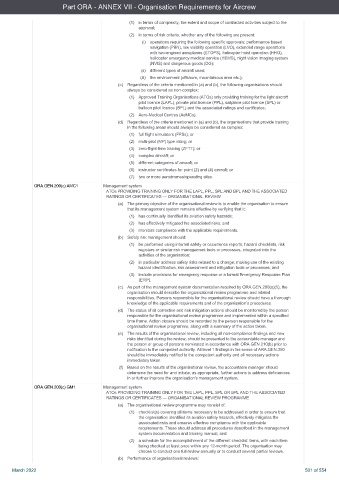Page 501 - UK AirCrew Regulations (Consolidated) March 2022
P. 501
Part ORA - ANNEX VII - Organisation Requirements for Aircrew
(1) in terms of complexity, the extent and scope of contracted activities subject to the
approval;
(2) in terms of risk criteria, whether any of the following are present:
(i) operations requiring the following specific approvals: performance based
navigation (PBN), low visibility operation (LVO), extended range operations
with two-engined aeroplanes (ETOPS), helicopter hoist operation (HHO),
helicopter emergency medical service (HEMS), night vision imaging system
(NVIS) and dangerous goods (DG);
(ii) different types of aircraft used;
(iii) the environment (offshore, mountainous area etc.);
(c) Regardless of the criteria mentioned in (a) and (b), the following organisations should
always be considered as non-complex:
(1) Approved Training Organisations (ATOs) only providing training for the light aircraft
pilot licence (LAPL), private pilot licence (PPL), sailplane pilot licence (SPL) or
balloon pilot licence (BPL) and the associated ratings and certificates;
(2) Aero-Medical Centres (AeMCs).
(d) Regardless of the criteria mentioned in (a) and (b), the organisations that provide training
in the following areas should always be considered as complex:
(1) full flight simulators (FFSs); or
(2) multi-pilot (MP) type rating; or
(3) zero-flight-time training (ZFTT); or
(4) complex aircraft; or
(5) different categories of aircraft; or
(6) instructor certificates for point (2) and (4) aircraft; or
(7) two or more aerodromes/operating sites.
ORA.GEN.200(c) AMC1 Management system
ATOs PROVIDING TRAINING ONLY FOR THE LAPL, PPL, SPL AND BPL AND THE ASSOCIATED
RATINGS OR CERTIFICATES — ORGANISATIONAL REVIEW
(a) The primary objective of the organisational review is to enable the organisation to ensure
that its management system remains effective by verifying that it:
(1) has continually identified its aviation safety hazards;
(2) has effectively mitigated the associated risks; and
(3) monitors compliance with the applicable requirements.
(b) Safety risk management should:
(1) be performed using internal safety or occurrence reports, hazard checklists, risk
registers or similar risk management tools or processes, integrated into the
activities of the organisation;
(2) in particular address safety risks related to a change; making use of the existing
hazard identification, risk assessment and mitigation tools or processes; and
(3) include provisions for emergency response or a formal Emergency Response Plan
(ERP).
(c) As part of the management system documentation required by ORA.GEN.200(a)(5), the
organisation should describe the organisational review programme and related
responsibilities. Persons responsible for the organisational review should have a thorough
knowledge of the applicable requirements and of the organisation’s procedures.
(d) The status of all corrective and risk mitigation actions should be monitored by the person
responsible for the organisational review programme and implemented within a specified
time frame. Action closure should be recorded by the person responsible for the
organisational review programme, along with a summary of the action taken.
(e) The results of the organisational review, including all non-compliance findings and new
risks identified during the review, should be presented to the accountable manager and
the person or group of persons nominated in accordance with ORA.GEN.210(b) prior to
notification to the competent authority. All level 1 findings in the sense of ARA.GEN.350
should be immediately notified to the competent authority and all necessary actions
immediately taken.
(f) Based on the results of the organisational review, the accountable manager should
determine the need for and initiate, as appropriate, further actions to address deficiencies
in or further improve the organisation’s management system.
ORA.GEN.200(c) GM1 Management system
ATOs PROVIDING TRAINING ONLY FOR THE LAPL, PPL, SPL OR BPL AND THE ASSOCIATED
RATINGS OR CERTIFICATES — ORGANISATIONAL REVIEW PROGRAMME
(a) The organisational review programme may consist of:
(1) checklist(s) covering all items necessary to be addressed in order to ensure that
the organisation identified its aviation safety hazards, effectively mitigates the
associated risks and ensures effective compliance with the applicable
requirements. These should address all procedures described in the management
system documentation and training manual; and
(2) a schedule for the accomplishment of the different checklist items, with each item
being checked at least once within any 12-month period. The organisation may
choose to conduct one full review annually or to conduct several partial reviews.
(b) Performance of organisational reviews:
March 2022 501 of 554

